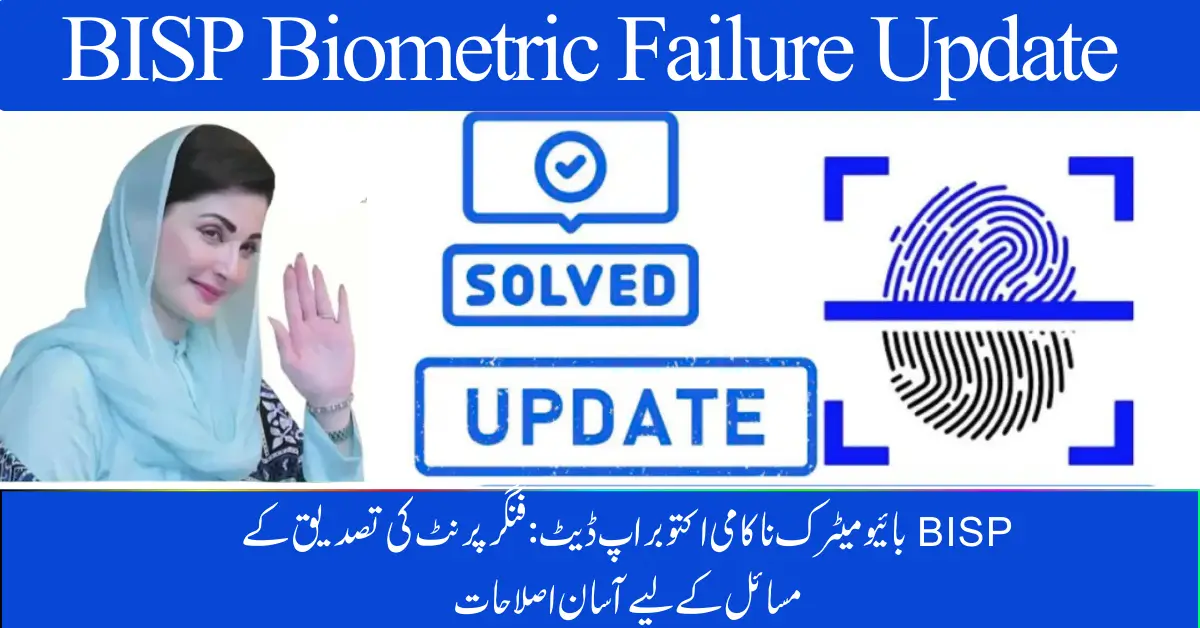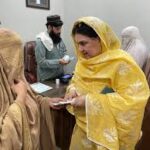The Benazir Income Support Program (BISP) 8171 has been a lifeline for millions of poor and deserving families in Pakistan. It provides financial assistance to those who are unable to meet basic household needs. However, despite its widespread benefits, one of the most common challenges faced by beneficiaries is the issue of biometric verification failure. Whenever a beneficiary tries to withdraw cash through an HBL ATM, a bank branch, or a designated shop, they are required to go through biometric verification.
This step is crucial because it ensures that payments are being collected by the right person and prevents fraud. Unfortunately, in many cases, the system fails to recognize fingerprints and the message “biometric verification failed” appears, which causes stress, confusion, and delay in receiving financial assistance. For those depending on these payments, even a small delay becomes a big hurdle.
This guide has been created to provide a complete, detailed, and updated solution to the problem of biometric verification failure in BISP 8171. It will explain why this issue occurs, what steps can be taken immediately to resolve it, how NADRA plays a role in fixing it, and what alternative options are available for beneficiaries who permanently face this problem.
By the end of this article, you will have a clear understanding of the exact process and practical tips to overcome biometric issues and continue receiving payments smoothly in 2025.
Why Biometric Verification Fails in BISP 8171
Biometric verification relies on fingerprints, and while the system is designed to be accurate and secure, multiple reasons cause failures. The most common reasons include faint or unclear fingerprints, especially among elderly citizens and women engaged in housework such as cooking, cleaning, and laundry.
Over time, fingerprints fade and become difficult to scan. Similarly, manual laborers and farmers who work with tools, soil, and machinery often suffer from rough or damaged skin that biometric devices struggle to recognize. Apart from this, dirt, oil, or moisture on hands at the time of verification can also prevent the machine from reading the prints correctly.
Another reason for failure is related to the biometric device itself. Not all scanners are of high quality, and some may be poorly maintained or outdated. Sometimes, the issue is not with the person’s fingerprints but with the scanner at the bank or retailer shop.
Technical errors such as weak internet connectivity or malfunctioning machines also lead to rejections. A very important factor is outdated NADRA data. If someone has not updated their CNIC biometrics for many years, the fingerprints stored in the system may not match current prints, leading to continuous verification problems.
Step-by-Step Solution for BISP 8171 Biometric Verification Failed
When biometric verification fails, it does not mean you cannot collect your payment. The following step-by-step solutions are recommended:
1. Clean and Prepare Hands Before Verification
Always make sure your hands are clean and dry before placing them on the scanner. Wash your hands with soap and water to remove dirt, grease, or moisture. Dry them thoroughly, as even slight dampness can affect recognition. Avoid applying lotion, mehndi, or oil before visiting the payment point, as these substances interfere with scanner accuracy.
2. Try Different Fingers
NADRA has recorded multiple fingerprints for every CNIC holder. If your thumb is not working, try using the index or middle finger. Inform the staff at the BISP payment center or ATM that your fingerprint is not being recognized and request them to attempt verification with another finger. Many beneficiaries succeed on the second or third attempt with a different finger.
3. Visit a Different Biometric Machine
If fingerprints are repeatedly rejected on one machine, try another location. For example, if you are facing biometric failure at an HBL ATM, go to a nearby retailer shop authorized for BISP payments or try another ATM. Machines vary in sensitivity, and sometimes another scanner will accept fingerprints without issue.
4. Update Your Biometric Record with NADRA
If you continue facing problems, the next important step is visiting the nearest NADRA office for biometric data update. NADRA will re-capture your fingerprints and update your CNIC record. This update ensures that the system has your latest fingerprints and significantly reduces the chances of failure during BISP verification. Keep your CNIC renewed and biometrics updated every few years to avoid such issues in the future.
5. Contact the BISP 8171 Helpline
If problems persist even after multiple attempts, call the official BISP helpline at 0800-26477. Explain your issue clearly and provide your CNIC number. The helpline staff can check your status, guide you to the nearest facilitation center, or provide instructions on how to proceed.
6. Apply for Exemption from Biometric Verification
For elderly citizens, disabled persons, or individuals with permanent fingerprint damage, BISP allows exemption from biometric verification. In such cases, the beneficiary has to visit the nearest BISP office or District Administration office with their CNIC and a medical certificate, if applicable. Once verified, the exemption is approved, and payments can be collected through manual verification.
7. Use Nominee Option
If you are permanently unable to complete biometric verification, BISP allows you to nominate a trusted family member. This nominee must be registered with NADRA and verified by BISP. After approval, the nominee can collect payments on your behalf, ensuring that your financial support continues without disruption.
Tips to Prevent Biometric Failures
-
Keep hands clean and dry during verification.
-
Do not apply any cream, lotion, or oil before using a biometric scanner.
-
Try multiple fingers instead of only relying on the thumb.
-
Renew and update CNIC records regularly with NADRA.
-
Visit BISP payment centers during less crowded hours for better chances of accurate scanning.
-
In case of repeated failure, go directly to NADRA for biometric recapturing instead of wasting time with multiple attempts.
Alternative Methods of Collecting Payments
While biometric verification is the primary method for security reasons, the government has introduced alternative methods for those who genuinely face biometric difficulties. These include OTP verification through a registered mobile number, manual verification at a district-level BISP office, and the nominee collection system for senior citizens or disabled beneficiaries.
These options are considered only after proper approval and documentation, ensuring that beneficiaries continue receiving support without facing repeated rejection.
BISP 8171 Biometric Verification Failed – Frequently Asked Questions
Q: What should I do if my fingerprints do not work at HBL ATM?
If your thumb is not working, try another finger such as the index or middle finger. If still unsuccessful, visit another ATM or a BISP retailer shop to attempt verification.
Q: Can I collect BISP payment without biometric verification?
Yes, but only in special cases like permanent disability or old age. You must apply for exemption through the BISP facilitation center.
Q: Will updating NADRA biometrics solve the issue permanently?
Yes, in most cases updating biometrics with NADRA ensures accurate fingerprint recognition and prevents repeated failures.
Q: What is the helpline number for BISP biometric issues?
You can call 0800-26477 for free assistance regarding biometric failures and solutions.
Role of NADRA in Biometric Verification
NADRA is responsible for maintaining the biometric records of all CNIC holders. Whenever you attempt verification for BISP 8171, your fingerprints are matched against NADRA’s database. If your record is outdated, incomplete, or mismatched, the system rejects your verification. This is why keeping your CNIC updated is crucial. NADRA offices provide the facility to recapture fingerprints, update records, and ensure your identity is correctly reflected in government databases.
Summary of Solutions
-
Clean and dry your hands before using the biometric machine.
-
Try different fingers if one is not recognized.
-
Use another biometric device at a different location.
-
Update biometric data at NADRA office.
-
Contact BISP helpline for further instructions.
-
Apply for exemption if biometrics are permanently unrecognizable.
-
Use the nominee system for disabled or elderly beneficiaries.
Conclusion
The BISP 8171 biometric verification failed solution is not as complicated as it may seem. Most issues are temporary and can be resolved by cleaning hands, trying multiple fingers, or using another machine. For long-term solutions, updating biometric data with NADRA is highly recommended. Beneficiaries who are unable to verify fingerprints due to age or disability can apply for exemptions or use the nominee option.
The government and BISP are committed to ensuring that every deserving family receives its due financial support without interruption. If you face repeated biometric problems, do not panic. Instead, follow the steps outlined in this guide, contact the BISP helpline, or visit NADRA for assistance. With these solutions, you can continue receiving your payments smoothly in 2025 and beyond.

